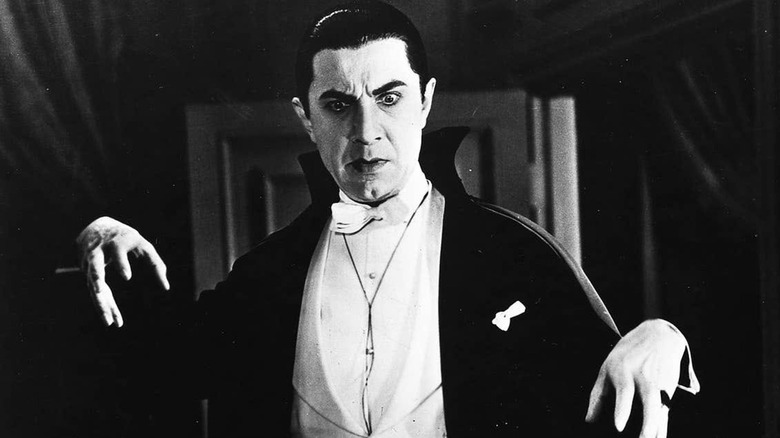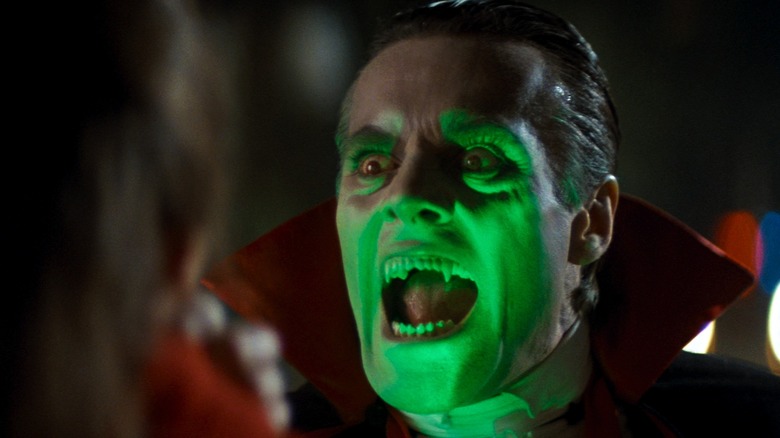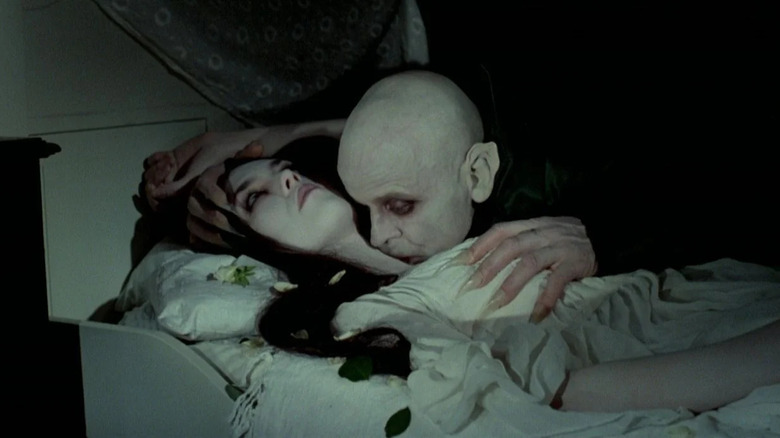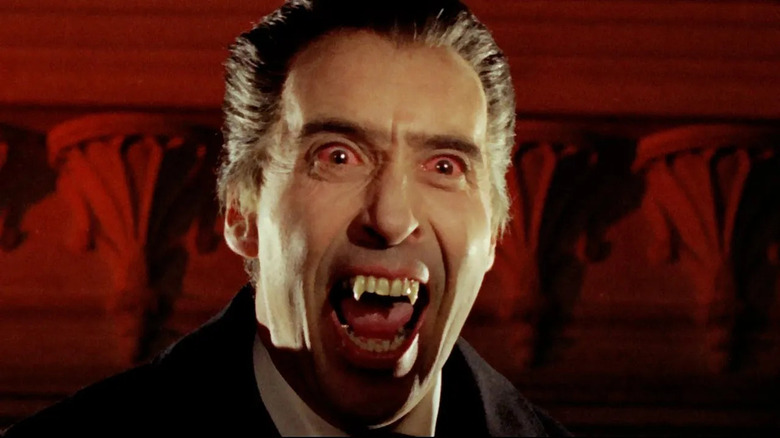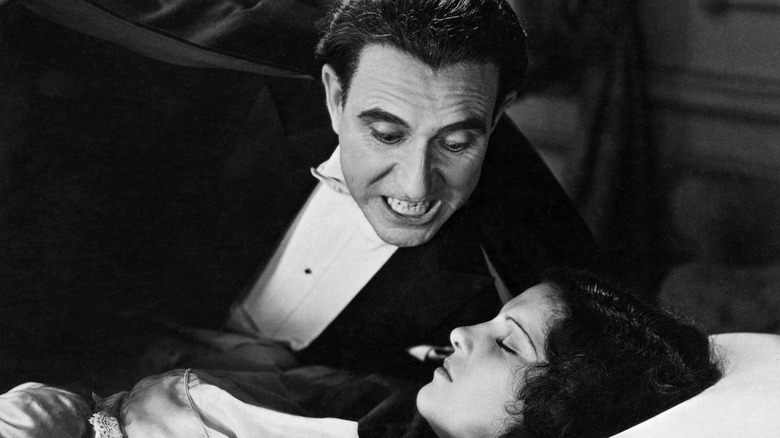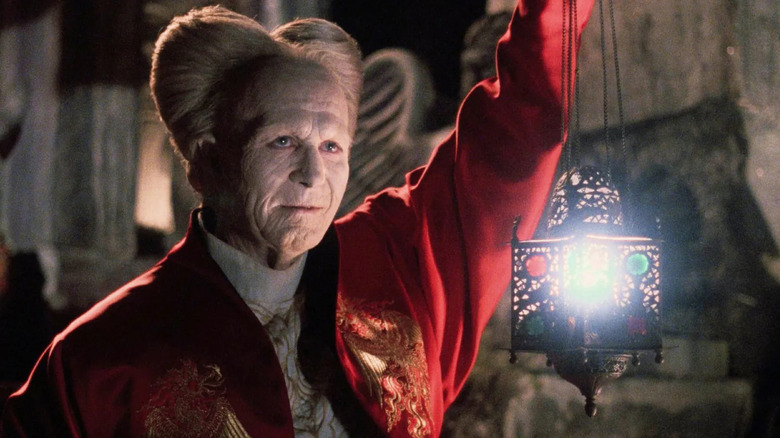The 5 Best Dracula Movies Ranked
"Abigail" is hitting theaters this weekend, bringing audiences a new vampire film to sink their teeth into. With that in mind, we're turning to the granddaddy of all vampires, Dracula! There are a lot of Dracula movies. Too many to Count, in fact (pun intended). Dracula has been to space ("Dracula 3000"). Dracula has turned out to be Judas Iscariot ("Dracula 2000"). Dracula has been to the Old West ("Billy the Kid Versus Dracula").
Hell, Dracula has been with us more or less since horror movies began (with the unauthorized adaptation "Nosferatu"). With that in mind, it's probably impossible to make a comprehensive list of every Dracula movie. So we're not even going to try to do that. Instead, we're going to list the five best Dracula movies, ranked. With so many Drac-centric flicks out there, any list like this is bound to be controversial. If your personal favorite Dracula movie didn't make the list, well, we're sorry about that.
5. The Monster Squad
Fred Dekker's delightful monster mash "The Monster Squad" features one of the very best movie Draculas, played by Duncan Regehr. With his slicked-back hair and penchant for calling children "b*tch," this Dracula is a real piece of sh*t. Regehr doesn't bother to play his Count Dracula as seductive or even charming. Instead, he's like a comic book villain, obsessed with world domination and not above using sticks of dynamite to blow up a kid's tree house. He drives around in a friggin' hearse with a skull hood ornament! At one point, a bolt of lightning flashes, and Dracula's head turns into a skull. Why? Because it's really cool, that's why. While other monsters appear in "The Monster Squad," the movie really belongs to this petty scumbag version of Dracula, who hisses at people like a feral cat. He's such a jerk and it's absolutely perfect. I only wish Regehr had gotten the chance to play Dracula again because he's so damn good at it.
4. Nosferatu the Vampyre
Why is the remake of "Nosferatu" on here but not the original? Technicalities, that's why! F. W. Murnau's silent movie classic isn't technically a "Dracula" movie. Rather than pay the rights to the novel (this was back before the character was in the public domain, mind you), Murnau and company merely took the "Dracula" framework and bent it to their whim, naming their vampire Count Orlock. However, when Werner Herzog remade the film in 1979, he wasn't bound by such constraints. As a result, his vampire, played by Klaus Kinski, is named Count Dracula, and the characters around him bear names from Bram Stoker's novel as well. Herzog's take on the material feels like the most melancholy movie ever made. There's a ghoulish sadness to this material, and Dracula seems less like an evil creature of the night and more like the loneliest being on the planet. It's a haunting, death-drenched movie that doesn't frighten so much as it traumatizes.
3. Dracula (aka Horror of Dracula) (1958)
Believe it or not, Bela Lugosi's Dracula doesn't have fangs. Instead, the concept of the fanged vampire is more likely the result of Hammer's "Dracula," aka "Horror of Dracula," where Christopher Lee wore some pointy chompers to play the Count. Whereas the original "Dracula" was swathed in black and white, the Hammer "Dracula" had the benefit of color — a concept used to great effect. Lugosi may be the most famous version of the Count, but he's closely followed by Christopher Lee, a towering actor who reportedly had never seen another Dracula performance when he took the role in the Terence Fisher-directed vampire film. Lee's Dracula is instantly iconic, bounding on the screen and surrounded by gothic opulence. Story-wise, the '58 "Dracula" starts off seeming like any other "Dracula" movie, with Jonathan Harker arriving at the Count's castle. But ah, there's a twist! Harker turns out to be a vampire hunter sent by Dracula's nemesis, Van Helsing, played by Peter Cushing. The Lee/Cushing pairing, which had previously happened in the Hammer film"The Curse of Frankenstein," proved to be perfect, and several "Dracula" sequels followed. But the original is still the best.
2. Dracula (and the Spanish-language Dracula) (1931)
Here are two Draculas for the price of one! Tod Browning's 1931 "Dracula" invented the Dracula movie as we know it, featuring Bela Lugosi's now-iconic turn as the blood-sucking count. The film is renowned for a reason and was a massive hit for the then-floundering Universal Studios. It kicked off the Universal horror movie, a concept that essentially saved the studio from ruin during the Great Depression. Adaptation-wise, it's a loose take on Bram Stoker's novel. And here's the thing: it's not even the best "Dracula" movie from 1931. Hoping to double their profits, Universal shot a Spanish-language version of "Dracula" using a new cast but the same sets. When the American "Dracula" crew would go home for the night, director George Melford and his Spanish-language cast would come in and shoot the same movie in Spanish until morning broke.
While Browning's film gets most of the attention these days, Melford's "Dracula" is actually superior, at least from a filmmaking standpoint. Browning's "Dracula" is rather stiff, full of unmoving wide shots that make his movie feel like a filmed play, whereas Melford and his cinematographer George Robinson were more creative, with dynamic shots that put Browning's work to shame. But Browning had one thing Melford did not: Lugosi. Carlos Villarías, who played the Spanish-language Dracula, is fine — but Lugosi owns the part, with his piercing eyes and phonetic dialogue delivery. One wishes they could drop Lugosi into the Spanish-language version to craft the perfect 1931 "Dracula."
1. Bram Stoker's Dracula
I know someone, somewhere, will be shocked that I have Francis Ford Coppola's "Bram Stoker's Dracula" at the top of the list, but I stand by this choice, damn it! Coppola's 1992 vampire extravaganza is a symphony of horrors; a big, bold, bloody, erotic, gothic, over-the-top spookshow full of mind-blowing practical visual effects (no digital trickery here; all the special effects are done in-camera).
Coppola and screenwriter James V. Hart take Bram Stoker's text and rework it into a sprawling romantic epic, where Dracula (as played by Gary Oldman wearing various forms of make-up) is a tragic figure looking for his long-lost love. He's still a monster, mind you, but you sort of understand where he's coming from. This sympathetic take on the character is far removed from Stoker's book, and yet, the film also stays closer to its source material than most other "Dracula" adaptations. A stacked cast (including a scene-stealing Anthony Hopkins as Van Helsing), gorgeous costumes courtesy of Eiko Ishioka, and a killer, bombastic musical score via Wojciech Kilar, all come together to create the ultimate vampire movie. Hollywood hasn't churned out anything even remotely close to this since its release.
We spoke more about Dracula and our favorite vampire movies on today's episode of the /Film Daily podcast, which you can listen to below:
You can subscribe to /Film Daily on Apple Podcasts, Overcast, Spotify, or wherever you get your podcasts, and send your feedback, questions, comments, concerns, and mailbag topics to us at bpearson@slashfilm.com. Please leave your name and general geographic location in case we mention your e-mail on the air.
